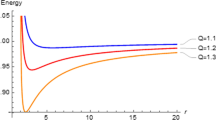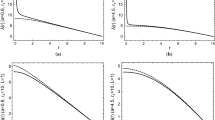Abstract
We consider the C-metric as a gravitational field configuration that describes an accelerating black hole in the presence of a semi-infinite cosmic string, along the accelerating direction. We adopt the expression for the gravitational energy-momentum developed in the teleparallel equivalent of general relativity (TEGR) and obtain an explanation for the acceleration of the black hole. The gravitational energy enclosed by surfaces of constant radius around the black hole is evaluated, and in particular, the energy contained within the gravitational horizon is obtained. This energy turns out to be proportional to the square root of the area of the horizon. We find that the gravitational energy of the semi-infinite cosmic string is negative and dominant for large values of the radius of integration. This negative energy explains the acceleration of the black hole that moves towards regions of lower gravitational energy along the string.




Similar content being viewed by others
Notes
We remark that when \(C=1\), the line element (6), and consequently the set of tetrad fields (25), does not represent ordinary Minkowski space-time, but just a partition of the latter, delimited by the acceleration horizons. In Section 5 of Ref. [1], it is very clearly stated that test particles at the origin \(r=0\) acquire acceleration along the \(\pm z\) directions, which is certainly not a feature of ordinary, full Minkowski space-time.
References
J. B. Griffiths, P. Krtouš and J. Podolský, “Interpreting the C-metric,” Class. Quantum Grav. 23, 6745–6766 (2006).
Torben C. Frost and Volker Perlick, “Lightlike geodesics and gravitational lensing in the spacetime of an accelerating black hole,” Class. Quantum Grav. 38, 085016 (2021).
T. Levi-Civita, Rend. Accad. Lincei 27, 343–351 (1918).
J. Ehlers and W. Kundt, “Exact solutions of the gravitational field equations,” in Gravitation: an Introduction to Current Research (Ed. L. Witten, Wiley, New York, 1962), pp. 49–101.
Jiří Bičák and David Kofroň, “Accelerating electromagnetic magic field from the C-metric,” Gen. Rel. Grav. 41, 1981-2001 (2009).
B. Mashhoon and U. Muench, “Length measurement in accelerated systems,” Ann. Phys. (Berlin) 11, 532 (2002).
B. Mashhoon, “Vacuum electrodynamics of accelerated systems: Nonlocal Maxwell’s equations,” Ann. Phys. (Berlin) 12, 586 (2003).
J. W. Maluf, F. F. Faria, and S.C. Ulhoa, “On reference frames in spacetime and gravitational energy in freely falling frames,” Class. Quantum Grav. 24, 2743 (2007).
J. W. Maluf and F. F. Faria, “On the construction of Fermi–Walker transported frames,” Ann. Phys. (Berlin) 17, 326 (2008).
J. W. Maluf, “Hamiltonian formulation of the teleparallel description of general relativity,” J. Math. Phys. 35, 335 (1994).
J. W. Maluf, “The gravitational energy-momentum tensor and the gravitational pressure,” Ann. Phys. (Berlin) 14, 723 (2005).
J. W. Maluf, F. F. Faria, and K. H. Castello-Branco, “The gravitational energy–momentum flux,” Class. Quantum Grav. 20, 4683 (2003).
J. W. Maluf and F. F. Faria, “On gravitational radiation and the energy flux of matter,” Ann. Phys. (Berlin) 13, 604 (2004).
J. W. Maluf, “The teleparallel equivalent of general relativity,” Ann. Phys. (Berlin) 525, 339 (2013).
J. W. Maluf, J. F. da Rocha-Neto, T. M. L. Toríbio, and K. H. Castello-Branco, “Energy and angular momentum of the gravitational field in the teleparallel geometry,” Phys. Rev. D 65, 124001 (2002).
S. B. Babak and L. P. Grishchuk, Phys. Rev. D 61, 024038 (1999).
M. O. Katanaev, “Geometric theory of defects,” Phys. Uspekhi 48x(7), 675-701 (2005).
M. O. Katanaev, “Introduction to the geometric theory of defects,” Lectures at III Summer School in Modern Mathematical Physics, 20-31 August 2004, Zlatibor, Serbia and Montenegro; cond-mat/0502123.
J. W. Maluf and A. Goya, “Space-time defects and teleparallelism,” Class. Quantum Grav. 18, 5143-5154 (2001).
J. D. Brown and J. W. York, Jr., “Quasi-local energy and conserved charges derived from the gravitational action,” Phys. Rev. D 47, 1407 (1993).
Author information
Authors and Affiliations
Corresponding authors
Ethics declarations
The authors declare that they have no conflicts of interest.
Rights and permissions
About this article
Cite this article
Carneiro, F.L., Ulhoa, S.C. & Maluf, J.W. On the Black Hole Acceleration in the C-Metric Space-Time. Gravit. Cosmol. 28, 352–361 (2022). https://doi.org/10.1134/S0202289322040077
Received:
Revised:
Accepted:
Published:
Issue Date:
DOI: https://doi.org/10.1134/S0202289322040077




